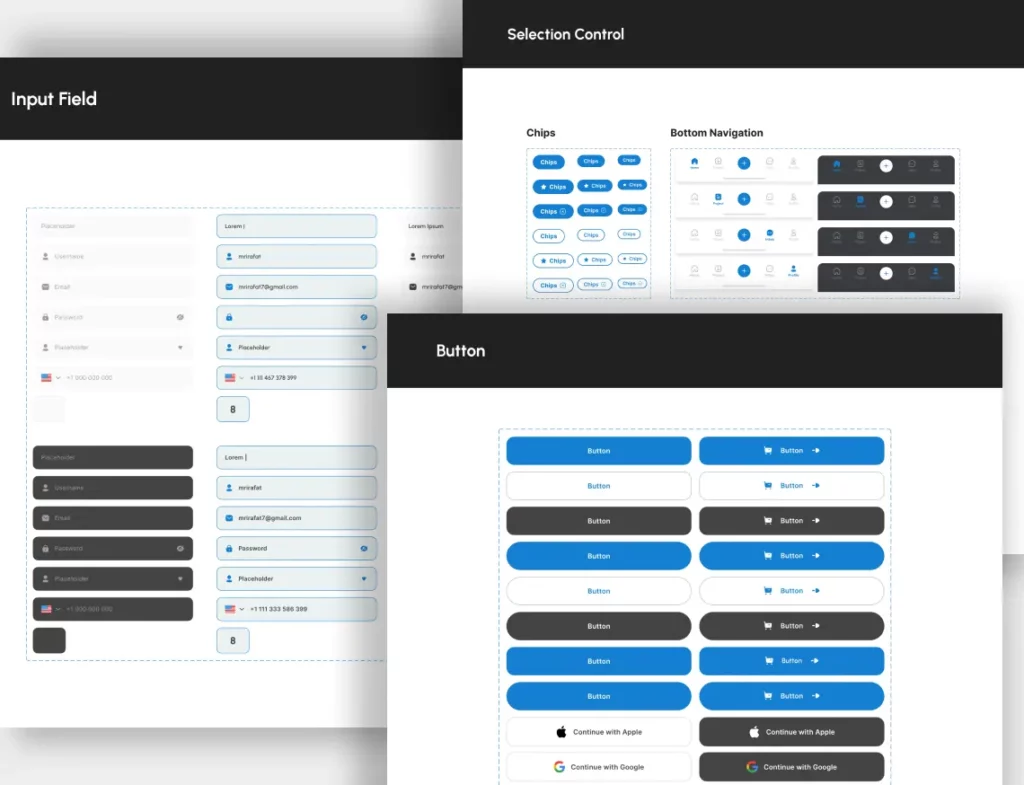In today’s fast-paced environment where digital commerce plays a pivotal role, customers not only demand high-quality products and services but also expect a superior user experience. This is where UI/UX design becomes crucial.
UI and UX design, although often used interchangeably, have distinct meanings and implications for the quality and usability of digital products or services. In the realm of digital commerce, understanding why UI/UX design matters for your business growth is essential.
By comprehending the significance of UI and UX design, businesses can create engaging and user-friendly digital experiences that meet the evolving demands of customers in the digital commerce landscape.
UI Design
UI design is about making things look good and easy to use. It involves creating buttons, icons, and other visual elements that make a product or app nice to look at and easy to interact with.

Some of the main elements of UI design are listed below:
- Layout: It means how things are placed on the screen, like pictures, buttons, and words. It’s important because it affects how people use the app or product.
- Color: Colors for the UI elements play a very vital role in brand communication, leaving psychological effects on users’ mood, readability, and accessibility.
- Typography: Properties of the text on the screen, such as font, size, and alignment, impact how easy it is to read, understand, and consume the information written in text form. It also gives the design its own style.
- Icons: Icons are small pictures that represent actions or ideas on the screen. They help users know what different parts of the product or application do.
- Images: Images help communicate the context of the information presented on the screen. There are different types of images we use, such as photos, illustrations, graphs, etc. Images help users understand features, content, or functions visually.
- Animation: Everyone likes moving, or interactive elements on the web page because it gives a sense of dynamism and engagement. We use several types of animations, such as transitions, visual feedback, loading animations, etc., to make the UI lively.
- HCI: Human-computer interaction is the study of how people use and work with computers or digital devices. HCI and UI go hand in hand to make products that are easy to use, accessible, and make users happy.
UX Design
User Experience, or in short, UX design, is all about how users feel and experience the digital product or application. UX design is a method of analyzing and improving the user’s experience, including how easy it is to use, whether it helps people achieve their goals.

Now, let’s see how a good UX design strategy and execution of the same can make your product or service successful.
Having a defined UX design strategy based on user research can make your target audience happier. When you work with a talented team of UI/UX designers, they can help you identify the pain points and solve them. A painless user experience will naturally help you reach your business goals for your product or service.
Here are some ways a strong UX design strategy can benefit your business.
User Centered Design
The most important principle of UX design is to put the user/human at the center of the design process.
User-Centered Design is a proven process for product design. A process that focuses on the target audience all the time, which helps deliver what the user wants instead of what we want. When we focus on the user’s needs, we ultimately design the offering – it can be a mobile app or an ecommerce website – be easy to adopt and desirable.
User centered design focuses on a few key points all the time. These are
- Understanding how use people (or will use) the application
- What are their expectations and
- Involving them in the design process from start to finish
These core components help designers make sure users find the final product easy to use and desirable.

By following the user-centered design process, UI/UX designers keep several factors, such as the user’s needs, goals, and behaviors, in mind when designing the product or application.
Keeping the user always at the center helps ensure that the product is useful, usable, and desirable, which is essential for the success of your product.
The importance of learning about users through things like surveys, group discussions, and testing helps designers understand who users are and what they like and dislike.
Designers use this research data to design a product or application that is tailored to the needs of the target users. Such a research-based design approach can result in increased customer satisfaction, increased customer loyalty, and increased sales.
Improved User Experience
A good user experience is extremely important for any business, regardless of whether it is online or offline business. UX design directly affects the happiness of customers.
A team of UI/UX designers works to make sure the product or app they create is easy to use, looks nice, and gives users a good feeling.
Looking to create superior user experiences?
One way they do this is by making the navigation simple and easy to understand. That way, users can find what they want and do what they need to do. This makes customers happier and more likely to keep using the product.
UI/UX designers also make the product look clean and simple. This makes it nice to look at and easy to use. When customers like how visually appealing something is and how easy it is to use, they’re happier overall.
Increased Conversion Rates
When a product or app is designed to keep the user at the center. It can attract more customers and make them more likely to transact. This is because a good user experience design connects customers emotionally and helps them achieve their goals effortlessly.
UI/UX designers understand the importance of creating enjoyable, easy-to-use, and, more importantly, desirable product experiences. This can make it easier for customers to adopt the product and do what they want, which helps convert visitors into shoppers and loyal customers.
Designers also use statistics and data to heal pain points. They analyze how customers interact with the products and how we can further iterate the flow or design to provide an elevated experience. When customers have a good experience, they’re more likely to buy something.
Enabling 2X growth by designing online experiences
Increased Customer Satisfaction
Customer happiness is the most important thing for businesses, If the customer is not happy with the product, app, or service, you can’t expect the success of your product.
The UX team plays a pivotal role in making sure customers are happy with the customer touchpoint, whether it is an app or a product. Customers have a great experience when the product is easy to use and understand, and they can perform the tasks effortlessly.
UI/UX designers use several methods to analyze, understand user actions and design the flow accordingly, which ensures smooth transitions. When users find a product or service that meets their desires, they usually stick with it and advocate for it.
Accessibility is also an important aspect we, as UX designers, consider when designing any product. Accessibility means it can be used by everyone, even people with different disabilities. This ensures that not a single person is left behind, which makes more people able to use the product.
Improved Brand Image
A well-designed product can have a positive impact on your brand. And a good user experience strategy leads to a good impression of the whole company, which can make people recognize the brand and happily advocate your product or company. Some examples of the same are Casper, Airbnb and Dropbox.
UI/UX designers understand the importance of creating a consistent visual style and user experience across all products and platforms, which is essential for creating a strong brand image. They work to ensure that the product or application they create is visually appealing and has a consistent look and feel, which can help create a positive impression of the brand.
In addition, UI/UX designers also consider the overall brand message when designing, which is important for ensuring that the product or application aligns with the brand image and goals of the company.
Conclusion
UI/UX design is vital for any business to perform well. It helps make customers happy, increases sales, and helps establish the brand in the user’s mind.
When you work with the UX design team, you can deliver products or apps that meet user needs. This makes customers emotionally connected and more likely to keep using them.
When you invest in UI/UX design, you make sure products and apps offer a great user experience. This helps you stay ahead of your competition and be successful in the long run.
A version of this blog was first published on Medium.com
Banner photo courtesy by Alvaro Reyes on Unsplash




 Ingeniería
Ingeniería







